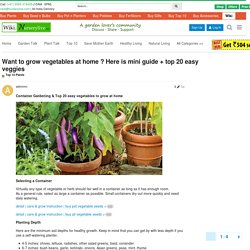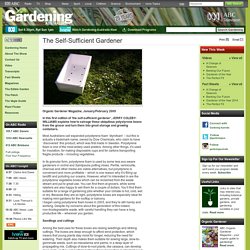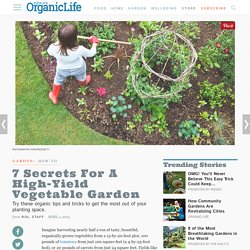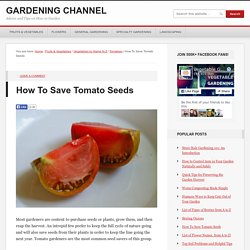

Want to grow vegetables at home ? Here is mini guide + top 20 easy veggies - Top 10 Plants - NurseryLive Discussion Forum. Container Gardening & Top 20 easy vegetables to grow at home Selecting a Container Virtually any type of vegetable or herb should fair well in a container as long as it has enough room.

As a general rule, select as large a container as possible. Small containers dry out more quickly and need daily watering. detail | care & grow instruction | buy pot vegetable seeds >368 detail | care & grow instruction | buy all vegetable seeds >645 Planting Depth Here are the minimum soil depths for healthy growth. Gardening Australia - The Self-Sufficient Gardener. Organic Gardener Magazine, January/February 2009 In this first edition of ‘the self-sufficient gardener’, JERRY COLEBY-WILLIAMS explains how to salvage those ubiquitous polystyrene boxes from the grocer and turn them into great storage and growing containers.

Most Australians call expanded polystyrene foam ‘styrofoam’ – but this is actually a trademark name, owned by Dow Chemicals, who claim to have ‘discovered’ this product, which was first made in Sweden. Polystyrene foam is one of the most widely used plastics. Among other things, it’s used for insulation, for making disposable cups and for cartons transporting fragile products – including vegetables. In its granular form, polystyrene foam is used by some less eco-aware gardeners in orchid and Saintpaulia potting mixes. Seedlings and cuttings Among the best uses for these boxes are raising seedlings and striking cuttings.
Preparing the box Here’s how to prepare the boxes for planting:1. Suitable crops Great insulators.
Raised Beds. 4 simple Trellises. DIY-bag-manual-2012_2.pdf. 4 Vegetables You Can Easily Grow in a Container. Growing Cucumbers. 7 Secrets for a High-Yield Vegetable Garden. The fastest way to get that deep layer of fertile soil is to make raised beds.

Raised beds yield up to four times more than the same amount of space planted in rows. That’s due not only to their loose, fertile soil but also to efficient spacing—by using less space for paths, you have more room to grow plants. Raised beds save you time, too. One researcher tracked the time it took to plant and maintain a 30-by-30-foot garden planted in beds, and found that he needed to spend just 27 hours in the garden from mid-May to mid-October.
Yet he was able to harvest 1,900 pounds of fresh vegetables—that’s a year’s supply of food for three people from about 3 total days of work! How do raised beds save so much time? Related: The Ultimate Compost Bin 2. In a 20-foot-long bed, for example, rounding the top increases your total planting area from 100 to 120 square feet. 3. Just be careful not to space your plants too tightly. Related: DIY Raised Garden Beds 4. 5. 6. 21 Vegetables that can grow in partial shade. Knowing where to grow your vegetables is almost as important as knowing what types to grow in the first place.

Your temperature zone defines what you can easily grow, but your ultimate placement of those chosen vegetables will decide how well they’ll grow for you. Here is a list of full sun, shade, and partial sun plants that grow well in most of North America. (Click through on the link for each vegetable to learn more about it.) Full Sun Vegetables “Full sun” means a minimum of six hours (usually at least 8) of sunlight per day.
Cucumbers One of the easiest to grow, cukes have very broad leaves, a common trait in many full-sun plants. Eggplant These grow better in some climates than in others, but are a popular early spring and late fall harvest. Peppers Most types of peppers prefer as much sun as they can get. Squash Like cucumbers, squash plants have very broad leaves and beg for sunlight. How To Save Tomato Seeds. Most gardeners are content to purchase seeds or plants, grow them, and then reap the harvest.

An intrepid few prefer to keep the full cycle of nature going and will also save seeds from their plants in order to keep the line going the next year. Tomato gardeners are the most common seed savers of this group. Why? Because once you’ve found the right variety or even created your own that is particularly well-suited to your area and methods, you don’t want to lose it. So you keep the seeds germinating year after year. Which Tomato Seeds to Save Most commercial and many non-commercial hybrid varieties are not likely to breed true from generation to generation. Nearly all heirlooms and commercial non-hybrid varieties are great for seed saving, however. Pollination is not an issue since all varieties of tomato are self-pollinating, though some hybrids are sterile and cannot pollinate or be pollinated at all.
Process of Saving Tomato Seeds.